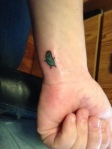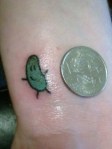** Please note: This blog post was written in whole or in part as an assignment for a class that I was taking. If you decide to use some of my work in your own assignments, please give credit where credit is due and cite your source! Thanks :) **
This one ended up being a little bit long, so feel free to skip it if you like! And let me know if you disagree with my diagnoses or treatment plans! I’m only taking this class for a brief time, and it probably won’t be where my career path ends, but I’ve always been interested in Psychology, so I’d love to hear others opinions!
The assignment is to write an analysis of each case. For each case, include the following:
- An analysis of the situation and possible causes for the subject’s behavior
- A preliminary diagnosis of the subject’s disorder using the symptoms he or she displays
- The set of therapies you suggest for helping the subject deal with his or her symptoms
Karen
Karen is a 30-year-old single woman. She was referred to a psychiatrist after six visits to her primary care physician complaining of headaches, body aches, sharp pains above her left ear, and a ringing in both ears. She was convinced she had a brain tumor, but a CAT scan revealed no physiological cause.
During the interview, Karen mentions that she doesn’t like being in a hospital “because being in a hospital puts you at risk for so many other diseases.” When pressed, she mentions swine flu, avian flu, and AIDS. Karen does not use illegal substances or alcohol. She carries hand sanitizer and discreetly spritzes it on her hands about every ten minutes or so. Part way through the interview, Karen put on sunglasses “to block the fluorescent rays” from the overhead lamps.
Family History: Father died three years ago of cancer. Mother is still alive. Grandmother committed suicide at 31 when mother was eight. Grandfather is still alive, with history of alcoholism.
ANALYSIS
Karen frequently feels symptoms of problems that do not exist physiologically. She takes great pains to prevent diseases and viruses. Minor aches and pains are interpreted as severe and do not go away, despite visiting her doctor multiple times and having tests and scans done. Frequent use of hand sanitizer shows an obsessive desire to be free of germs and keep her “safe.” She seems to be trying to get a handle on things that are out of her control.
CAUSES
These problems could stem from her father’s death from cancer. She may be using the symptoms as a way of coping with her father’s death, her grandfather’s alcoholism, or even to distract from being single at age 30.
PRELIMINARY DIAGNOSIS
Karen seems to be suffering from the somatoform disorder of hypochondriasis. She feels that she is suffering from serious physical illness (the brain tumor) where there is none. Her life is disrupted by being overly concerned with a variety of different diseases that could be caught while in the hospital, and takes great pains to keep her hands clean and prevent the rays from the fluorescent lamps.
Karen also exhibits signs of obsessive-compulsive disorder, with her obsessive hand sanitizer use. This may be a way to attempt to keep control on things that she can’t control. This could stem from her father’s cancer or her grandmother’s suicide, things that were out of her control.
TREATMENT/THERAPY
I think that many different types of therapy could be beneficial for Karen’s condition. Cognitive-Behavioral Therapy (CBT) would probably be the best type of therapy, as it would help her recognize the behaviors that are detrimental, look at them realistically, and change them. Incorporating behavior therapy using fear-reduction methods such as systemic desensitization or virtual therapy could be helpful when she is ready to face her fears and learn to cope with them. This type of therapy would help with both the obsessive-compulsive tendencies and the hypochondriasis.
Drugs such as antidepressants could also be helpful for some of her symptoms.
Perla
Perla is a 50-year-old woman in a same sex partnership. She arrived with a stack of pages from the Internet that “proved” that she has adult-onset ADHD. She mentions that she has long periods of activity, including not sleeping for days. She says she “self-medicates” with marijuana, energy drinks like Red Bull, and sleeping pills.
During the interview, it is hard to keep up with Perla. She bounces around the room and from topic to topic. When the interviewer asks her to fill out a questionnaire, she asks for a stapler. She then proceeds to simply staple her ADHD pages to the form. The interviewer asks Perla to complete the survey on the form, Perla becomes irate: “I already did your damn work for you. I told you I have ADHD!”
Family History: Unknown. Perla was adopted from Venezuela as a baby.
ANALYSIS
Perla seems to have a lot of energy and has become fixated on the idea that she has ADHD. She clearly put a lot of effort into completely researching the condition and feels that she has proven beyond a shadow of a doubt that she has it. She uses different mind altering chemicals depending on what her mood. She becomes agitated easily when someone disagrees with her.
CAUSES
Possible causes for these symptoms could be the use of marijuana, energy drinks and sleeping pills that she takes, or could even be related to hormonal changes based on her age. She may be feeling stress from her relationship, depending on the acceptance of her same-sex partnership by others. Since we know nothing of her family history, it is possible that genetic factors are involved as well.
PRELIMINARY DIAGNOSIS
Perla would most likely be classified as having bipolar disorder, particularly displaying manic characteristics. She is restless with long periods of activity including insomnia, which she attempts to correct cyclically with uppers and downers like energy drinks, marijuana, and sleeping pills. During the conversation she showed rapid flight of ideas jumping from topic to topic, typical of manic behavior. It is uncertain from this situation if she also suffers from depression. She exhibits irritability, and seems desperate to find a final answer to her mood, implying mood swings.
TREATMENT/THERAPY
Bipolar disorder is another type of disorder that can be treated with a variety of different types of therapies. Cognitive therapy can be helpful here, as it helps the patient locate their own problems and ways of thinking and make changes to them, and helps patients cope with stress. Group therapy could also be helpful because often hearing other people having the same types of issues can lead the patient to better understand their own ways of thinking.
Although our book only touched on Interpersonal Psychotherapy (IPT), a little more research on this topic shows that many therapists are using this type of treatment for patients with bipolar disorder. The National Institute of Mental Health also talks about Interpersonal and Social Rhythm Therapy (IPSRT) which combines IPT with behavioral therapy to help patients develop a regular routine to help stabilize their life. Since IPT focuses on social relationships, this type of therapy is particularly helpful because it helps patients develop routines that include others involved in their life as well as just themselves.
<http://www.nimh.nih.gov/health/topics/psychotherapies/index.shtml>
Typically patients with bipolar disorder will require medication such as mood stabilizers so that they are able to accept other types of therapy, which are used in conjunction with the medication.
Jordan
Jordan is a 22-year-old man who received medical discharge from the army after a 2-year tour in Iraq. The initial discharge was for depression, but Jordan’s family has begun to believe that it may be more complicated. Jordan has been discovered wandering at night “following the way the flags are showing me to go” or following a possibly imaginary woman with a scarred neck.
During the interview, Jordan seems lucid, but lethargic. He drums his fingers slowly on each thigh, as if playing a slow piano scale. His answers are all one or two words, such as “fine” or “I guess.” When asked about the woman with the scarred neck, he becomes slightly more animated.
Jordan: She’s a beautiful woman, isn’t she?
Interviewer: I don’t know, Jordan. I’ve never seen her.
Jordan: Right, because you don’t have the ring.
Interviewer: What ring?
Jordan: [mumbles]
Interviewer: Can you tell me about the ring?
Jordan: I said the ring is the fuse.
Interviewer: The fuse to what, Jordan?
Jordan: Without the fuse… well, you know what happens. It’s a fuse.
Interviewer: I don’t, Jordan. What happens?
Jordan: Fuses light up you know. And then, they blow up. That’s all.
Family History:Mother and father are still alive, but divorced. Mother is remarried. Mother has history of diabetes. Father’s leg was amputated during first Gulf War. History of emotional abuse by father.
ANALYSIS
Jordan shows many different symptoms that can fit different psychological disorders. He was obviously showing signs of depression or that could be taken as depression, since that was the reason for his discharge from the army. His wanderings and statements about flags and the woman with the scarred neck seem the be delusional or hallucinatory. Jordan’s mood in the interview is lucid but lethargic and he might be listening to piano music inside his head. When answering questions about the woman with the scarred neck, his thoughts are disjointed and disorganized, and odd.
CAUSES
There are many different factors to consider as a cause for many different diagnoses. He could be affected by hidden fear since his father had his leg amputated after serving in the Gulf War. Emotional abuse by his father could play a role in causing any number of different psychological disorders. If his mother had complications during her pregnancy because of her diabetes, this too could be the root cause of some disorders.
PRELIMINARY DIAGNOSIS
My initial preliminary diagnosis is schizophrenia, with an emphasis on disorganized schizophrenia. I am hesitant to use this as a diagnosis since it affects such a small percentage of the worldwide population and neither of his parents appear to have the disorder, however Jordan is only 22 and early onset is typical in those affected. His thinking and communication skills are disjointed and disorganized, and he jumps from topic to topic. During the interview he had trouble with paying attention and communicating. He shows signs of social withdrawal and his thought seem preoccupied. He is apparently seeing things that are not there, such as the woman with the scarred neck, and there are indications of auditory hallucinations as well, if he was in fact playing a slow piano tune with his fingers. His motor activity is slower and responses to questions seem emotionless most of the time. If his mother had complications during pregnancy, this could be another indicator towards a diagnosis of schizophrenia, since this can also be a risk factor.
Another possible diagnosis could be Major Depressive Disorder (MDD) due to his initial diagnosis of depression at the time of his discharge. Psychomotor retardation could explain some of his behaviors during the interview. Some symptoms of MDD include delusions and hallucinations as well.
TREATMENT/THERAPY
Whether the diagnosis is schizophrenia (of any type) or major depressive disorder, a combination of medication and psychotherapy would be required, and it would be required long-term. Antidepressants and cognitive-behavior type of therapy would most likely be best for major depressive disorder. A diagnosis of schizophrenia would require a combination of antidepressants, antipsychotics, and anti-anxiety medications as well as therapy. Therapy could be cognitive therapy, group therapy, and family therapy. Group and family therapy would help Jordan because having a support system is important for those with this diagnosis to keep them on the medications, since that is the thing that most people forget and which causes their symptoms to come back again. Setting up a life-long plan would be imperative in keeping everything in track for him to keep the symptoms at bay.
<http://psychcentral.com/disorders/sx31t.htm>



